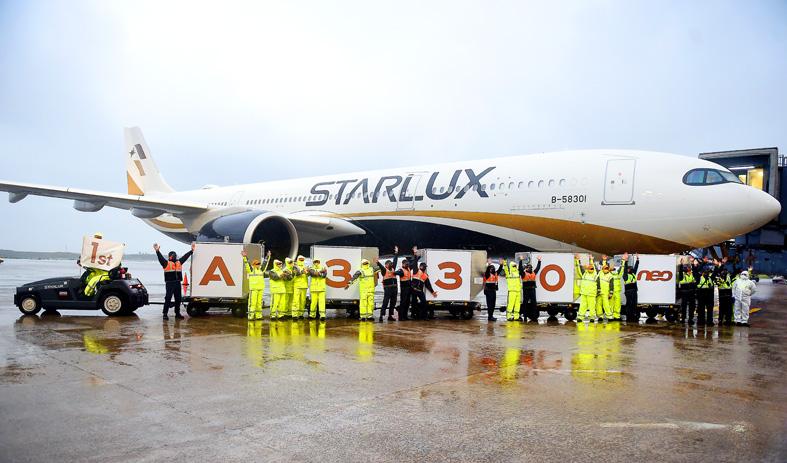Start-up Starlux Airlines Co (星宇航空) earlier this month had a fresh capital injection of NT$4 billion (US$136.94 million) at the request of the country’s top aviation regulator, after the airline reported a net loss of NT$3.01 billion for the whole of last year.
Ninety percent of the NT$4 billion came from Starlux chairman Chang Kuo-wei (張國煒) and the other 10 percent from other major shareholders and StarLux employees, the airline said in a statement yesterday.
Starlux said it would continue to review whether more capital is needed.

Photo: Chu Pei-hsiung, Taipei Times
The injection brought the airline’s paid-in capital to NT$15.36 billion, company data showed.
Starlux, which was established in 2018 and offered its first flight in January 2020, has had a bumpy ride because of the COVID-19 pandemic — it reported an aggregate net loss of NT$5.4 billion over the past two years, the largest loss among local airlines, data released by the Civil Aeronautics Administration (CAA) showed.
Late last year, the CAA required the airline to increase its capital because its accumulated losses totaled NT$6.93 billion, more than half of its paid-in capital of NT$11.36 billion.
Unlike other airlines that have shifted to air cargo to offset the loss in passenger revenue during the COVID-19 pandemic, Starlux’s cargo capacity is limited, as it only operated six single-aisle Airbus A321neo planes last year, company data showed.
However, the airline said it still tried to increase its revenue by shifting its flights to destinations with stable passenger demand, as well as cities that are hubs for cargo operations, it said.
Starlux’s revenue last year totaled NT$795 million, doubling from a year earlier and ranking fifth in Taiwan, after China Airlines (CAL, 中華航空), EVA Airways Corp (長榮航空), Uni Airways Co (立榮航空) and Mandarin Airlines (華信航空), CAA data showed.
Starlux’s growth in revenue is the highest among local airlines, followed by CAL’s 24 percent rise and EVA Airways’ 20 percent increase, the CAA data showed.
However, Starlux’s net assets per share last year stood at NT$3.96, the lowest among local airlines, while its debt ratio was 82 percent, the second-biggest after Daily Air Corp’s (德安航空) 87 percent, the data showed.
The airline said it plans to receive more A321neo jets and A330neo planes this year to expand its capacity on the expectation that air travel would recover as countries ease their border controls.

CHIP RACE: Three years of overbroad export controls drove foreign competitors to pursue their own AI chips, and ‘cost US taxpayers billions of dollars,’ Nvidia said China has figured out the US strategy for allowing it to buy Nvidia Corp’s H200s and is rejecting the artificial intelligence (AI) chip in favor of domestically developed semiconductors, White House AI adviser David Sacks said, citing news reports. US President Donald Trump on Monday said that he would allow shipments of Nvidia’s H200 chips to China, part of an administration effort backed by Sacks to challenge Chinese tech champions such as Huawei Technologies Co (華為) by bringing US competition to their home market. On Friday, Sacks signaled that he was uncertain about whether that approach would work. “They’re rejecting our chips,” Sacks

NATIONAL SECURITY: Intel’s testing of ACM tools despite US government control ‘highlights egregious gaps in US technology protection policies,’ a former official said Chipmaker Intel Corp has tested chipmaking tools this year from a toolmaker with deep roots in China and two overseas units that were targeted by US sanctions, according to two sources with direct knowledge of the matter. Intel, which fended off calls for its CEO’s resignation from US President Donald Trump in August over his alleged ties to China, got the tools from ACM Research Inc, a Fremont, California-based producer of chipmaking equipment. Two of ACM’s units, based in Shanghai and South Korea, were among a number of firms barred last year from receiving US technology over claims they have

BARRIERS: Gudeng’s chairman said it was unlikely that the US could replicate Taiwan’s science parks in Arizona, given its strict immigration policies and cultural differences Gudeng Precision Industrial Co (家登), which supplies wafer pods to the world’s major semiconductor firms, yesterday said it is in no rush to set up production in the US due to high costs. The company supplies its customers through a warehouse in Arizona jointly operated by TSS Holdings Ltd (德鑫控股), a joint holding of Gudeng and 17 Taiwanese firms in the semiconductor supply chain, including specialty plastic compounds producer Nytex Composites Co (耐特) and automated material handling system supplier Symtek Automation Asia Co (迅得). While the company has long been exploring the feasibility of setting up production in the US to address

OPTION: Uber said it could provide higher pay for batch trips, if incentives for batching is not removed entirely, as the latter would force it to pass on the costs to consumers Uber Technologies Inc yesterday warned that proposed restrictions on batching orders and minimum wages could prompt a NT$20 delivery fee increase in Taiwan, as lower efficiency would drive up costs. Uber CEO Dara Khosrowshahi made the remarks yesterday during his visit to Taiwan. He is on a multileg trip to the region, which includes stops in South Korea and Japan. His visit coincided the release last month of the Ministry of Labor’s draft bill on the delivery sector, which aims to safeguard delivery workers’ rights and improve their welfare. The ministry set the minimum pay for local food delivery drivers at